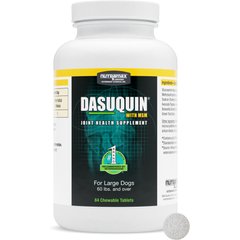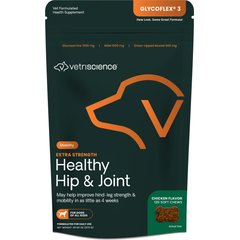Glucosamine for Dogs: Uses, Benefits, Dosage, and Side Effects

Photo by undefined undefined/iStock via Getty Images Plus
Key Takeaways
- Glucosamine may support healthy cartilage and smooth joint movement in dogs.
- Veterinarians may recommend glucosamine to help with a dog’s arthritis, hip dysplasia, or age-related stiffness.
- Combining glucosamine with chondroitin or MSM may enhance joint protection.
- It’s generally safe when used as directed—but always confirm dosage and type of product with your vet.
- Consistent use of glucosamine may help with comfort and mobility support for your pup.
What Is Glucosamine for Dogs?
If you aren’t familiar with glucosamine, don’t worry. It’s pretty simple to understand once you know the function it provides and how it supports your dog’s joints.
Glucosamine is a naturally occurring compound in your dog’s cartilage, the smooth rubber covering that cushions their joints. This molecule helps the body produce the lubrication to keep cartilage flexible and joint fluid healthy.
As dogs age, or if they develop conditions like osteoarthritis or hip dysplasia, their bodies produce less glucosamine. This means their cartilage may become less flexible and can decrease their mobility.
According to the American Veterinary Medical Association, glucosamine is one of the most commonly used joint supplements in veterinary medicine. In many studies, glucosamine has been found to support cartilage repair and mobility in dogs with chronic joint issues.
Common Signs Your Dog May Need Joint Support
Dogs don’t become “deficient” in glucosamine like they might with vitamins, but as natural production slows, cartilage thins and joint wear continues to break down.
This process—combined with genetics, excess weight, or injury—may lead to arthritis or joint degeneration.
If you notice any of the following signs in your pup, it’s worth a chat with your vet to determine if your dog may benefit from a supplement for joint support.
- Limping or favoring a leg
- Stiffness after naps or exercise
- Difficulty getting up or climbing stairs
- Reduced enthusiasm for walks or play
- Visible discomfort when touched near joints
Many pet parents think these changes are “just aging,” but joint discomfort is not inevitable. Starting joint support for your dog early, before severe pain develops, may help preserve function and increase your pup’s comfort.
The Benefits of Glucosamine for Dogs
When given on a regular basis and as directed by your vet, glucosamine may improve your dog’s joint health and overall mobility. Here’s how:
1. May Maintain and Repair Cartilage
Glucosamine provides building blocks for cartilage regeneration, which helps to protect against further wear and tear.
2. May Improve Mobility and Comfort
Giving your pup a joint supplement with glucosamine may help to reduce stiffness, which can lead to less pain and more general comfort for your dog.
3. May Slow Arthritis Progression
Long-term glucosamine use may slow cartilage breakdown, especially in dogs with osteoarthritis or hip dysplasia.
Glucosamine can be given in conjunction with omega-3 fatty acids, physical therapy, and weight management to enhance mobility and joint longevity.
Tip: Improvements are gradual. Most dogs show benefits after 4–6 weeks of consistent use, but results will depend on the type of product and individual dog.
Possible Side Effects of Glucosamine for Dogs
Glucosamine is typically safe for most dogs, but mild side effects can occur, especially when not used according to the manufacturer’s or your vet’s instructions.
When giving your dog any type of glucosamine, contact your vet if you notice any unusual side effects as soon as they start. Possible side effects when giving your dog glucosamine:
- Mild upset stomach (including soft stool, gas, or vomiting)
- Increased thirst or sleepiness
- Allergic reactions (especially if a dog has an ingredient allergy)
If your dog has any type of shellfish allergy, or has diabetes, kidney disease, or liver disease, do not start a glucosamine supplement without first consulting your vet.
Tip: If your pup has mild tummy issues when taking their glucosamine, give it to them with food. Always ensure fresh water is available.
How Much Glucosamine Can I Give My Dog?
Each dog’s needs will vary based on their weight, any health condition, and supplement type. Always follow your veterinarian’s instructions and the product label’s dosing guidelines to determine how much glucosamine to give your dog.
When to Call Your Vet
Contact your veterinarian if your dog:
- Develops worsening stiffness or lameness
- Shows pain when touched near hips or knees
- Doesn’t improve after 6 to 8 weeks of consistent use
- Has other chronic health issues or takes prescription medications
Keep in mind your vet may recommend X-rays, physical therapy, or prescription joint medications in combination with a glucosamine supplement.
How to Safely Give Your Dog Glucosamine
To get the most benefit from glucosamine supplementation:
- Look for a high-quality product: Find a dog joint supplement that is veterinarian-recommended and with a National Animal Supplement Council (NASC) Quality Seal.
- Pair wisely: Ask your vet about combining a joint supplement with chondroitin, MSM, or omega-3s for enhanced joint support.
- Follow directions: When administering, always follow the directions on the label and from your vet, when administering.
- Monitor progress: Track your dog’s mobility, energy, and activity level over several weeks to determine if the supplement is working.
Small, steady improvements—like easier rising or more playful behavior—are strong indicators that glucosamine is helping.
Best Glucosamine Supplements for Dogs
The best glucosamine supplement for your dog will depend on their individual health. Your vet is the best resource when it comes to making this decision.
A few supplements your vet may recommend:
Nutramax chews contain green tea extract and glucosamine, which supports a normal inflammatory response in joints. This chew also contains methylsulfonylmethane, or MSM, which helps maintain connective tissue.
Recommended Product
- VetriScience GlycoFlex Plus Extra Strength Healthy Hip and Joint Supplement for dogs.
These chews contain glucosamine as well as MSM and green-lipped mussels. Green-lipped mussels have been shown to help with joint pain and swelling in dogs with arthritis.
This dog joint supplement contains MSM and glucosamine plus phycocyanin, an extract derived from blue-green algae, which provides antioxidant support.
Recommended Product
- Nutramax Cosequin Joint Health Supplement with Glucosamine, Chondroitin, MSM, & Omega-3’s Soft Chews
This supplement uses glucosamine, chondroitin, MSM, and omega-3s to support healthy cartilage and joints.
Recommended Product
Tip: Look for products with the NASC Quality Seal, which ensures the highest-quality products, specifically health supplements, for pets.
FAQs About Glucosamine for Dogs
What does glucosamine do for dogs?
Glucosamine has been shown in studies to support cartilage repair, joint lubrication, and comfort, especially in older dogs or those with arthritis.
Can I give human glucosamine to my dog?
No. Human supplements may contain xylitol or other additives that are extremely toxic to dogs. Always work with your vet with choosing the best pet-safe glucosamine product.
How long does glucosamine take to work in dogs?
Most dogs show improvement within 4 to 6 weeks of consistent daily use, but results will vary depending on type of product and your individual dog.
Is glucosamine safe for puppies?
It can be safe for large-breed puppies under vet supervision but isn’t needed for healthy young dogs.
Can glucosamine prevent arthritis in dogs?
It may delay or reduce severity in at-risk dogs but cannot fully prevent arthritis.
What if my dog doesn’t improve?
Consult your vet. They may recommend alternative therapies like prescription joint support, pain relief, or physical therapy.
Attributions
This article was created with assistance from AI tools and has been reviewed for accuracy by a veterinarian.







